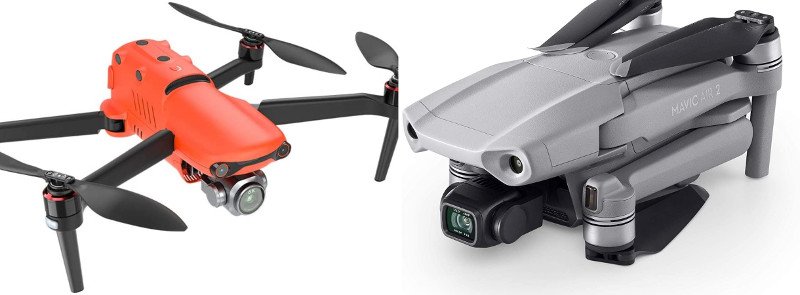Key Features – Autel Evo 2 Pro
- 6K/30fp, 4k/60fps, 1080/120fps camera
- 1080p live video stream
- 1-inch sensor
- Adjustable aperture
- 20MP still images
- 120Mbps
- 4*lossless zoom
- 3-axis mechanical gimbal
- 10-bit colour profile
- H.264/H.265 video codecs
- 40 minutes of flight time
- 9km range
- Omni-directional obstacle avoidance system
Key Features – DJI Mavic Air 2
- 4k/60fps, 2.7k/60fps, 1080p/240fps camera
- 1080p live video stream
- 1/2-inch sensor
- 12MP/48MP still images
- 120Mbps
- 3-axis gimbal
- HDR support
- Multiple panorama photography
- 8k hyperlapse videos
- 34 minutes of flight time
- 10km range
- 3-axis mechanical gimbal
- 3-way obstacle avoidance technology
Are you looking for a top of the range drone for photography? In this article, I will compare two of the best drones for photography in the Autel 2 Pro vs Mavic Air 2 and see which out of the two drones comes out on top.
DJI are without a doubt the leading company for high-end drones and their Mavic series is probably responsible for making the foldable drone design very popular.
Autel are DJI’s closest challengers and although they don’t have the range of drones that DJI have, the Evo 2 Pro is definitely one of the best drones for photography.
Both the Autel Evo 2 Pro and Mavic Air 2 have similar features, but they also have some major differences. Which drone is suitable for you will mainly depend on your budget and your overall preference. Many people still choose a DJI drone over other drone brands because of their name recognition and they do provide excellent customer service.
I personally prefer the DJI Mavic Air 2, even though the Autel 2 Pro is technically the superior drone.
Autel 2 Pro vs Mavic Air 2
Camera
As we are comparing two drones that have been built for professional photography, the first thing to compare is their respective cameras.
The Autel 2 Pro comes with the superior camera, it has a 1-inch CMOS sensor from Sony that has an adjustable aperture and allows you to capture HD images in 20MP with stunning clarity and detail. Images are captured in both RAW/JPEG and can record up to 1 billion colours for HDR imaging in post-production. It can shoot amazing night time photography via its NIGHTBEAT feature and captures hyperlapse photography in 6k.
It can record video footage in 6k at 30fps and the files can be stored in both MP4/MOV formats and records via the latest H.265 video compression technology for improved visual quality while taking up less memory space. You can also view live video feed at 1080p/720 resolution, and it has a detachable gimbal which will allow you to attach different cameras on the drone. As of writing this article, there is an 8k camera and an infrared imaging camera that are compatible with the Evo 2 Pro.
As for the Mavic Air 2, while it may not be technically on par with the Evo 2 Pro camera, it’s still a very good camera. It comes with a 1/2-inch Quad Bayer sensor that helps to capture amazing still images in 12&48MP with higher dynamic range.
The camera has a feature called SmartPhoto that combines different photography modes to automatically capture high-quality professional images at the click of a button. It combines HDR imaging, Hyperlight and scene recognition to capture the perfect photo in 12MP. This a good feature especially for people who are just beginning their drone photography journey.
Other features the camera comes with include capturing 8k hyprerlapse videos, multiple panorama photography modes and a feature called Quickshots that will allow you to capture short cinematic video footage from multiple angles completely hands-free.
Design
When it comes to aesthetics, the DJI Mavic Air 2 is my pick, this is a fantastic looking drone that has a smooth aerodynamic structure and comes with foldable arms. It’s much slimmer and more compact than the Evo 2 Pro and weighs half as much.
The Mavic Air 2 weighs just over 500g, which is light for a professional photography drone, however, its weight means you will have to register the drone if you live in the UK, Canada or the USA, this is true even if you have no plans to use it for commercial reasons. The same also applies to the Autel Evo 2 Pro and as drone laws are subject to constant updates as technology advances, you should always check what the rules are wherever you live just so make sure you comply with the law.
The Evo 2 Pro is a much bigger foldable drone, it’s bulkier and weighs just over 1kg, this extra weight and mass does have its advantages and one of them is that you will able to fly the drone in windy conditions.
Both drones come with a dual GPS system and have multiple sensors on the bottom that form a vision positioning system which will help with flight stabilisation, especially if you are flying in an area that has a weak GPS signal.
The Evo 2 is powered by an 11.55v 7100mAh lithium polymer battery, this is an intelligent battery that keeps its charge for longer, has LED indicator lights to highlight is power level and provides the drone with a flight time of 40 minutes.
The Mavic Air 2 is also powered by the same type of battery however, it has a rating of 3500mAh which provides a flight time of around 34 minutes, which is still good but not as good as the Evo 2 Pro.
As for the controllers, the Mavic Air 2 comes with a similar controller to that of the Mavic Pro 2. It’s much bigger than the original smaller controller that came with previous Mavic drones and dispute being larger, it is comfortable to hold. There is a smartphone clamp on the top and the power button as well as the return to home button in the middle. Between these two buttons, there is a switch that toggles between the 3 different flight modes of the drone. There are also buttons on the top for capturing images/videos and controlling the gimbal.
The Evo 2 retains the same controller as the original, it’s small and the main feature is its 3.3-inch OLED screen which will allow you to view live video feed without the need of a smartphone and the Autel Explorer app. The screen is useful as it provides with lots of telemetry data about the drone, it’s a nice feature that I wish other drone companies would follow. However, it is best to fly the drone with the aid of your smartphone and the app as it gives you access to more features.
The transmission range for the Evo 2 is 9km, this is slightly less than the Mavic Air 2 which utilises DJI’s advanced transmission technology called OcuSync 2.0 which allows you to control the drone from 10km.
Drone App
The Mavic Air 2 uses the new DJI Fly App, this is a relatively new app that was originally developed for the Mavic Mini. It’s a feature-rich app that is very user friendly, it’s easy to navigate, has some nice tutorials and you get access to its smart flight modes. Another cool feature is its video editing suite, it has various video templates that you can use to enhance the overall quality of your videos and then share them on to various social media accounts.
The Autel Explorer app has improved a lot from its initial release, it has a nice UI and you get access to the drones intelligent flight modes and have more control over the camera settings. It’s a good drone app but DJI still leads the way in this area.
Flight Features & Performance
The Mavic Air 2 comes with 3 flight modes, they are normal, sports and tripod.
Normal and Tripod modes are very similar, all the features work in this mode but in Tripod mode, the speed is limited which will allow you to shoot slow-motion cinematic footage. In sports mode, you can reach the drones maximum speed limit and the obstacle avoidance system is turned off, so this mode is suited for experienced pilots.
The Evo 2 Pro has similar flight modes, although it is not as straight forward as switching between different flight modes. You will have set your flight parameters within the app to slow down the drone or fly at its top speed.
Both drones come with autonomous flight modes that will allow you to fly the drone completely hands-free while you concentrate on taking better videos and images.
Theses intelligent flight modes come under different names for each drone, but they essentially do the same thing.
For example, the Evo 2 has an intelligent flight mode called dynamic track, which when activated will automatically follow you or any subject matter you lock the drone onto. The Mavic Air 2 has the exact same feature, but it is called active track. Both drones can track your subject matter from behind, parallel or from a fixed point
You can also orbit a point of interest with both drones and create flight paths on the app and the drone will fly along the route automatically.
The drones also come with safety features that include an automatic return to home and obstacle avoidance system.
The Autel Evo 2 has the more advanced obstacle avoidance technology as it has sensors all around the body that will sense obstacle from all directions. The Mavic Air 2 has sensors on its front, back and bottom for 3-way obstacle detection and avoidance system.
The Mavic Air also comes with a feature called Quickshots, these are pre-programmed flight modes that will allow you to record short cinematic videos from different angles.
As for flight performance, well, as you would expect from such high-end drones, they perform exceptionally well. The flight performance is stable and the range for both drones is more or less what is stated, both fly well in windy conditions, although because of its size and weight the Evo 2 is the stronger drone in this area.
Final Thoughts
As I stated near the beginning of this article, I personally prefer the DJI Mavic Air 2, mainly because it’s a DJI drone and I like its overall design and it comes with some amazing features. The Evo 2 has the superior camera and the gimbal is interchangeable which gives you the option of attaching a different camera on the drone. It also has a superior flight time and a better obstacle avoidance system. If you want more options, click on the button below to check my list of the best drones with a camera


